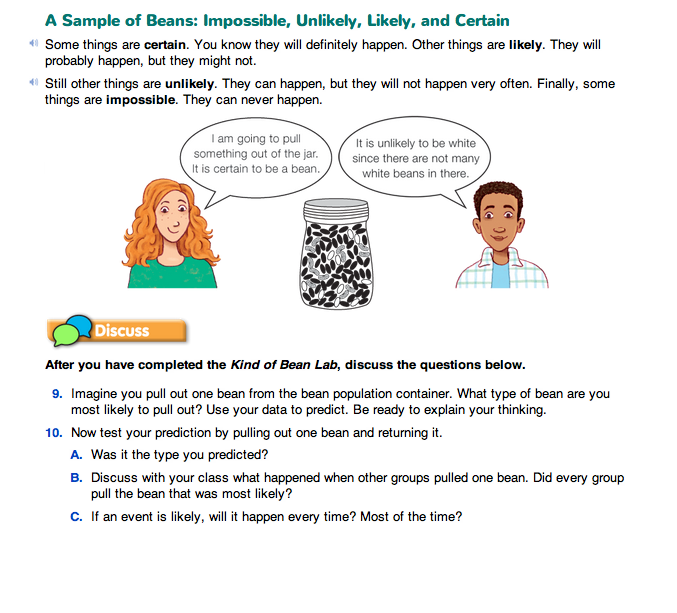Kind of Bean
Est. Class Sessions: 3Developing the Lesson
Part 3: Describe Events: Impossible, Unlikely, Likely, and Certain
Define Descriptions. Display the words “impossible,” “unlikely,” “likely,” and “certain” from left to right across the board. Explain that they can be used to describe whether something will happen. Students should discuss what the words mean with a partner or in small groups. After allowing time to think about the words, ask groups to share their definitions. Here are some sample answers:
Impossible: “I am sure it cannot happen.”
Unlikely: “It probably will not happen” or “It will not happen very often.”
Likely: “It probably will happen” or “It will happen most of the time.”
Certain: “I am sure it will happen.”
Brainstorm a class list of events that are impossible, unlikely, likely, and certain.
As students suggest events, write some on self-adhesive notes and ask volunteers to place the notes near the appropriate word on the board. After a few examples, have students write their own events and place their notes on the board. They might not agree on how to classify some events. For example, in one class a student was certain that “I will do my homework tonight.” It was difficult for her to imagine that unforeseen circumstances such as a power failure, illness, etc., could prevent that. Words such as “very likely” and “very unlikely” might help the class reach a consensus. Adhesive notes can be moved toward the right or left side of the board depending on how likely the events are. Here are some sample events:
Impossible: “I will grow wings tonight” or “My dog will swim across the ocean.”
Unlikely: “It will snow in Chicago in May” or “Three students will be named Jose in one classroom.”
Likely: “We will have school on Tuesday” or “We will eat lunch today.”
Certain: “The sun will come up tomorrow” or “Ice cubes will melt if I leave them outside on a hot day.”
Describe Kind of Bean Events. Discussion Questions 9–10 in the Student Guide follow a short paragraph containing definitions of the terms used to describe the likelihood of an event.
Question 9 asks each group to imagine pulling out one bean from the bean population. They use their data to predict what type of bean is most likely to be pulled out. Encourage each group to be ready to explain their prediction. The type of bean that is most common in their sample and in the bean population is the most likely to be pulled—the type of bean with the highest bar on their graph.
Question 10 then asks each student to pull out just one bean from the bean population and return it. Most students will pull the type they predicted, but some might not. Since the event “pulling out the most common bean” is likely but not certain, it may not happen every time, but it will happen most of the time.














